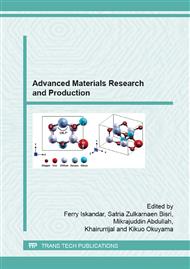[1]
J. Li, N. Zhang, K. Sun, W. Sun, and W. Li, A facile and environment-friendly method to fabricate thin electrolyte films for solid oxide fuel cells, J Alloys Compd, 509 (2011) 5388-5393.
DOI: 10.1016/j.jallcom.2011.02.057
Google Scholar
[2]
J.W. Fergus JW, Electrolytes for solid oxide fuel cells, J Power Sources, 162 (2006) 30-40.
DOI: 10.1016/j.jpowsour.2006.06.062
Google Scholar
[3]
K. Nomura, Y. Mizutani, M. Kawai, Y. Nakamur, and O. Yamamoto, Aging and Raman scattering study of scandia and yttria doped zirconia, Solid State Ionics, 132 (2000) 235-9.
DOI: 10.1016/s0167-2738(00)00648-2
Google Scholar
[4]
C. Haering, A. Roosen, and H. Schichl, Degradation of the electrical conductivity in stabilised zirconia systems: Part I: yttria-stabilised zirconia, Solid State Ionics, 176 (2005) 253-9.
DOI: 10.1016/j.ssi.2004.07.038
Google Scholar
[5]
C. Haering, A. Roosen, H. Schichl, and M. Schnöller, Degradation of the electrical conductivity in stabilised zirconia system: Part II: Scandia-stabilised zirconia, Solid State Ionics, 176 (2005) 261-8.
DOI: 10.1016/j.ssi.2004.07.039
Google Scholar
[6]
A. Yamaji, T. Koshikawa, W. Araki, and T. Adachi, Stabilization of a Zirconia System and Evaluation of Its Electrolyte Characteristics for a Fuel Cell: Based on Electrical and Mechanical Considerations, J Eng Mater Technol, 131 (2008) 011010.
DOI: 10.1115/1.3026557
Google Scholar
[7]
W. Araki, T. Koshikawa, A. Yamaji, and T. Adachi, Degradation mechanism of scandia-stabilised zirconia electrolytes: Discussion based on annealing effects on mechanical strength, ionic conductivity, and Raman spectrum, Solid State Ionics, 180 (2009).
DOI: 10.1016/j.ssi.2009.09.001
Google Scholar
[8]
N. Orlovskaya, S. Lukich, G. Subhash, T. Graule, and J. Kuebler J, Mechanical properties of 10mol% Sc2O3–1mol% CeO2–89mol% ZrO2 ceramics, J Power Sources, 195 (2010) 2774-81.
DOI: 10.1016/j.jpowsour.2009.11.016
Google Scholar
[9]
T.I. Politova, J.T.S. Irvine, Investigation of scandia–yttria–zirconia system as an electrolyte material for intermediate temperature fuel cells—influence of yttria content in system (Y2O3)x(Sc2O3)(11−x)(ZrO2)89, Solid State Ionics, 168 (2004).
DOI: 10.1016/j.ssi.2004.02.007
Google Scholar
[10]
F. Yuan, J. Wang, H. Miao, C. Guo, and W.G. Wang, Investigation of the crystal structure and ionic conductivity in the ternary system (Yb2O3)x–(Sc2O3)(0. 11−x)–(ZrO2)0. 89 (x=0–0. 11), J Alloys Compd, 549 (2013) 200-5.
DOI: 10.1016/j.jallcom.2012.09.089
Google Scholar
[11]
B. Bai, N.M. Sammes, and A.L. Smirnova, Physical and electrochemical characterization of Bi2O3-doped scandia stabilized zirconia, J Power Sources, 176 (2008) 76-81.
DOI: 10.1016/j.jpowsour.2007.10.074
Google Scholar
[12]
Y. Ota, M. Ikeda, S. Sakuragi, Y. Iwama, N. Sonoyama, S. Ikeda, et al, Crystal Structure and Oxygen Ion Conductivity of Ga3 + Co-Doped Scandia-Stabilized Zirconia, J Electrochem Soc, 157 (2010) B1707-B12.
DOI: 10.1149/1.3489377
Google Scholar
[13]
F. Boulc'h and E. Djurado, Structural changes of rare-earth-doped, nanostructured zirconia solid solution, Solid State Ionics, 157 (2003) 335-40.
DOI: 10.1016/s0167-2738(02)00230-8
Google Scholar
[14]
O.P. Arjasa and J. Raharjo. Facile One Pot Synthesis of Highly Monodisperse Silica Nanoparticles in Water Based Medium, Indonesian Journal of Material Science (Jurnal Sain Materi), 14 (2012) 34-9.
Google Scholar


